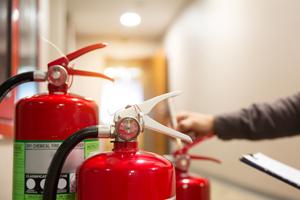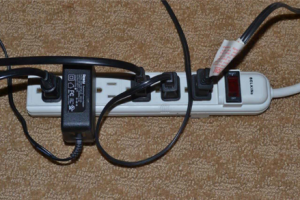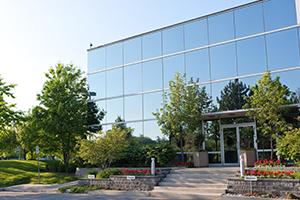Using temporary electricity safely
Does this apply to me?
Any work that requires the use of extension cords and temporary lighting will fall into the “temporary electricity” category.
What does this cover?
Extension cords
Cords have to be in good condition with the ground pin intact. Remind workers not to pull on cords to unplug them since that can damage the grounding pin.
Cords on power tools
Look for damage where cords are attached to tools. If the inner insulated wires are visible the tool needs to be repaired.
Temporary outlets
While they are cheap, metal knockout boxes from the local building supply store are not good as supply boxes, especially if they are used on the ground. Water and debris can get into them creating a path for electricity to energize the entire box. Make sure temporary outlets are protected from rain and water and that they are not loose when attached to plywood or other structures.
Temporary power cables
Cable on the floor or ground can be damaged easily so position them up off the floor; this also minimizes workers tripping/slipping on them.
Circuit breaker panels
Make sure there are no exposed energized parts and no openings on the sides. Only use metal front covers and make sure they are secured in place. If possible use ground fault circuit interrupter (GFCI) circuit breakers since these protect workers downstream.
Inspection program
Workers should inspect extension cords, outlets and power tools frequently. The OSHA rules also require this inspection process. All temporary electrical equipment has to be protected by a GFCI or an assured equipment grounding program (AEGP). The AEGP requires that cords, tools, and outlets are inspected each quarter by a competent person to make sure the path to ground is intact, wiring is properly installed and equipment is not damaged.
What else do I need to know?
While the main concern is worker safety, damaged or overloaded electrical components can result in fires. When too much current (amperage) is pulled through cords or outlets, a lot of heat is created. Damaged insulation can also contact metal and cause sparking or short circuits which can result in fires.
What about training?
Workers need to be trained in how to inspect cords and tools and what to do when they find damaged equipment.
Overhead power lines should also be a part of the training since many workers think they are insulated, when in fact they are not. Building scaffolds or using ladders and cranes near energized power lines can be fatal.
If any employees work on energized equipment they must be qualified, which requires special training. It is always best to de-energize any electrical equipment first.
Where can I get more help?
See the Hanover Risk Solutions website and the OSHA website electrical safety page for more information.
This material is provided for informational purposes only and does not provide any coverage or guarantee loss prevention. The examples in this material are provided as hypothetical and for illustration purposes only. The Hanover Insurance Company and its affiliates and subsidiaries (“The Hanover”) specifically disclaim any warranty or representation that acceptance of any recommendations contained herein will make any premises, or operation safe or in compliance with any law or regulation. By providing this information to you. The Hanover does not assume (and specifically disclaims) any duty, undertaking or responsibility to you. The decision to accept or implement any recommendation(s) or advice contained in this material must be made by you.
LC JAN 2019 12-374
171-1102 (10/14)
Using temporary electricity safely
Does this apply to me?
Any work that requires the use of extension cords and temporary lighting will fall into the “temporary electricity” category.
What does this cover?
Extension cords
Cords have to be in good condition with the ground pin intact. Remind workers not to pull on cords to unplug them since that can damage the grounding pin.
Cords on power tools
Look for damage where cords are attached to tools. If the inner insulated wires are visible the tool needs to be repaired.
Temporary outlets
While they are cheap, metal knockout boxes from the local building supply store are not good as supply boxes, especially if they are used on the ground. Water and debris can get into them creating a path for electricity to energize the entire box. Make sure temporary outlets are protected from rain and water and that they are not loose when attached to plywood or other structures.
Temporary power cables
Cable on the floor or ground can be damaged easily so position them up off the floor; this also minimizes workers tripping/slipping on them.
Circuit breaker panels
Make sure there are no exposed energized parts and no openings on the sides. Only use metal front covers and make sure they are secured in place. If possible use ground fault circuit interrupter (GFCI) circuit breakers since these protect workers downstream.
Inspection program
Workers should inspect extension cords, outlets and power tools frequently. The OSHA rules also require this inspection process. All temporary electrical equipment has to be protected by a GFCI or an assured equipment grounding program (AEGP). The AEGP requires that cords, tools, and outlets are inspected each quarter by a competent person to make sure the path to ground is intact, wiring is properly installed and equipment is not damaged.
What else do I need to know?
While the main concern is worker safety, damaged or overloaded electrical components can result in fires. When too much current (amperage) is pulled through cords or outlets, a lot of heat is created. Damaged insulation can also contact metal and cause sparking or short circuits which can result in fires.
What about training?
Workers need to be trained in how to inspect cords and tools and what to do when they find damaged equipment.
Overhead power lines should also be a part of the training since many workers think they are insulated, when in fact they are not. Building scaffolds or using ladders and cranes near energized power lines can be fatal.
If any employees work on energized equipment they must be qualified, which requires special training. It is always best to de-energize any electrical equipment first.
Where can I get more help?
See the Hanover Risk Solutions website and the OSHA website electrical safety page for more information.
This material is provided for informational purposes only and does not provide any coverage or guarantee loss prevention. The examples in this material are provided as hypothetical and for illustration purposes only. The Hanover Insurance Company and its affiliates and subsidiaries (“The Hanover”) specifically disclaim any warranty or representation that acceptance of any recommendations contained herein will make any premises, or operation safe or in compliance with any law or regulation. By providing this information to you. The Hanover does not assume (and specifically disclaims) any duty, undertaking or responsibility to you. The decision to accept or implement any recommendation(s) or advice contained in this material must be made by you.
LC JAN 2019 12-374
171-1102 (10/14)
Using temporary electricity safely
Does this apply to me?
Any work that requires the use of extension cords and temporary lighting will fall into the “temporary electricity” category.
What does this cover?
Extension cords
Cords have to be in good condition with the ground pin intact. Remind workers not to pull on cords to unplug them since that can damage the grounding pin.
Cords on power tools
Look for damage where cords are attached to tools. If the inner insulated wires are visible the tool needs to be repaired.
Temporary outlets
While they are cheap, metal knockout boxes from the local building supply store are not good as supply boxes, especially if they are used on the ground. Water and debris can get into them creating a path for electricity to energize the entire box. Make sure temporary outlets are protected from rain and water and that they are not loose when attached to plywood or other structures.
Temporary power cables
Cable on the floor or ground can be damaged easily so position them up off the floor; this also minimizes workers tripping/slipping on them.
Circuit breaker panels
Make sure there are no exposed energized parts and no openings on the sides. Only use metal front covers and make sure they are secured in place. If possible use ground fault circuit interrupter (GFCI) circuit breakers since these protect workers downstream.
Inspection program
Workers should inspect extension cords, outlets and power tools frequently. The OSHA rules also require this inspection process. All temporary electrical equipment has to be protected by a GFCI or an assured equipment grounding program (AEGP). The AEGP requires that cords, tools, and outlets are inspected each quarter by a competent person to make sure the path to ground is intact, wiring is properly installed and equipment is not damaged.
What else do I need to know?
While the main concern is worker safety, damaged or overloaded electrical components can result in fires. When too much current (amperage) is pulled through cords or outlets, a lot of heat is created. Damaged insulation can also contact metal and cause sparking or short circuits which can result in fires.
What about training?
Workers need to be trained in how to inspect cords and tools and what to do when they find damaged equipment.
Overhead power lines should also be a part of the training since many workers think they are insulated, when in fact they are not. Building scaffolds or using ladders and cranes near energized power lines can be fatal.
If any employees work on energized equipment they must be qualified, which requires special training. It is always best to de-energize any electrical equipment first.
Where can I get more help?
See the Hanover Risk Solutions website and the OSHA website electrical safety page for more information.
This material is provided for informational purposes only and does not provide any coverage or guarantee loss prevention. The examples in this material are provided as hypothetical and for illustration purposes only. The Hanover Insurance Company and its affiliates and subsidiaries (“The Hanover”) specifically disclaim any warranty or representation that acceptance of any recommendations contained herein will make any premises, or operation safe or in compliance with any law or regulation. By providing this information to you. The Hanover does not assume (and specifically disclaims) any duty, undertaking or responsibility to you. The decision to accept or implement any recommendation(s) or advice contained in this material must be made by you.
LC JAN 2019 12-374
171-1102 (10/14)
Using temporary electricity safely
Does this apply to me?
Any work that requires the use of extension cords and temporary lighting will fall into the “temporary electricity” category.
What does this cover?
Extension cords
Cords have to be in good condition with the ground pin intact. Remind workers not to pull on cords to unplug them since that can damage the grounding pin.
Cords on power tools
Look for damage where cords are attached to tools. If the inner insulated wires are visible the tool needs to be repaired.
Temporary outlets
While they are cheap, metal knockout boxes from the local building supply store are not good as supply boxes, especially if they are used on the ground. Water and debris can get into them creating a path for electricity to energize the entire box. Make sure temporary outlets are protected from rain and water and that they are not loose when attached to plywood or other structures.
Temporary power cables
Cable on the floor or ground can be damaged easily so position them up off the floor; this also minimizes workers tripping/slipping on them.
Circuit breaker panels
Make sure there are no exposed energized parts and no openings on the sides. Only use metal front covers and make sure they are secured in place. If possible use ground fault circuit interrupter (GFCI) circuit breakers since these protect workers downstream.
Inspection program
Workers should inspect extension cords, outlets and power tools frequently. The OSHA rules also require this inspection process. All temporary electrical equipment has to be protected by a GFCI or an assured equipment grounding program (AEGP). The AEGP requires that cords, tools, and outlets are inspected each quarter by a competent person to make sure the path to ground is intact, wiring is properly installed and equipment is not damaged.
What else do I need to know?
While the main concern is worker safety, damaged or overloaded electrical components can result in fires. When too much current (amperage) is pulled through cords or outlets, a lot of heat is created. Damaged insulation can also contact metal and cause sparking or short circuits which can result in fires.
What about training?
Workers need to be trained in how to inspect cords and tools and what to do when they find damaged equipment.
Overhead power lines should also be a part of the training since many workers think they are insulated, when in fact they are not. Building scaffolds or using ladders and cranes near energized power lines can be fatal.
If any employees work on energized equipment they must be qualified, which requires special training. It is always best to de-energize any electrical equipment first.
Where can I get more help?
See the Hanover Risk Solutions website and the OSHA website electrical safety page for more information.
This material is provided for informational purposes only and does not provide any coverage or guarantee loss prevention. The examples in this material are provided as hypothetical and for illustration purposes only. The Hanover Insurance Company and its affiliates and subsidiaries (“The Hanover”) specifically disclaim any warranty or representation that acceptance of any recommendations contained herein will make any premises, or operation safe or in compliance with any law or regulation. By providing this information to you. The Hanover does not assume (and specifically disclaims) any duty, undertaking or responsibility to you. The decision to accept or implement any recommendation(s) or advice contained in this material must be made by you.
LC JAN 2019 12-374
171-1102 (10/14)





